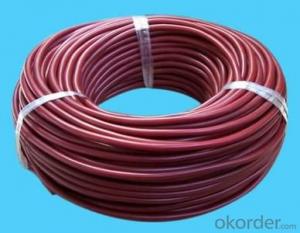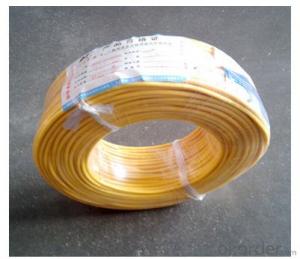High quality 35KV Insulated Overhead Cable
- Loading Port:
- Qingdao
- Payment Terms:
- TT OR LC
- Min Order Qty:
- 10000 m
- Supply Capability:
- 100000 m/month
OKorder Service Pledge
OKorder Financial Service
You Might Also Like
35KV Insulated Overhead Cable
Implemented standard
1KV GB/T12527 10KV GB/T 14049 35KV GB/T14049
Introduction
The product is made up of the copper, aluminum ( aluminum alloy) conductor, inner shield, climate- resistant insulation material and outer shield. It has simple structure and is safe and reliable. It has both excellent properties of the power cable and good physical properties of the aerial cable. By using the climate-resistant insulation material, the product has the excellent properties of resistance to air aging. Compare with the bare wire, it has the good characteristics such as smaller laying distance, hither reliability. It is suitable for using in the high buildings, brush land and bad weather zone.
Characteristics
1.There are three rated voltage: 1KV, 10KV, 35KV;
2.Allowed long-term working temperature:
PE insulation-70℃,PVC insulation-70℃,Cross-linked PE-90℃;
3.When short-circuit (the longest time is not more than 5 second), the highest temperature: PE insulation 130℃,PVC insulation 160℃,Cross-linked PE 250℃;
4.The environment temperature for laying should be not lower than -20℃;
5.The working environment temperature is from -40℃ to +40℃, the relative humidity should be not more than 90% in rainy season;
6.Permitted bending radius
Cable with rated voltage 1KV and below: outer diameter of the cable D≤25mm,bending radius should be not less than 4D. The outer diameter of cable D>25mm, bending radius should be not less than 6D.
Cable with rated voltage 10KV,35KV: Single core cable: 20*(D+d)±5% multiple core cable: 15*(D+d)±5%
In which:
D-the actual outer diameter of the cable, mm;
d-the actual outer diameter of the cable conductor, mm.
Introduction of our company
Our company is a professional China Wire and Cable Manufacturers, mainly supply Aerial bundled cable,House Electric Wire, Insulated Overhead Cable,Aluminium Conductor Steel Reinforced, PVC Control Cables,XLPE Power Cables,BV Electric Wires,Nylon Sheathed Cable,Buried Cable,High Voltage Cable,House Electric Wire,Single Core Flexible Copper Cable,Civil Wire And Cable etc. series of wire and cable products, sincerely welcome everyone to visit.
- Q: All the DIY info shows how to change a light fixture. What do you do with the wiring if you want to remove a chandelier, but not replace it with another?I want to make sure the wires in the ceiling are not capable of starting a fire. This is in the first floor of a two-story.
- With respect to the wiring instead of connecting wires to a new fixture they need to be capped with wire nuts instead. With respect to the empty area there are two approaches. If the box is neatly recessed in the ceiling then a larger decorative cover plate will do the job nicely. You do not want to use an electrical cover plate for the normal round box as it will leave unsealed edges around it. If the wires are long and the box is short you might adapt to a wiremold box that will include an adapting plate and the external round box that will project an inch down from the ceiling. Then you will need to add the decorative (wide) blank cover plate. Since you are asking this question there is also an obvious suggestion that you might have someone who is familiar with electrical wiring to do this as someone new to wiring might easily overlook something that a more experienced eye will catch.
- Q: i have a big box of many different kinds of wires (av, usb, power supplies, etc), but i don't know what most of them are and what they are used for. is there a website where i can find out what all of these wires are used for?
- You really have to identify the connector to identify the cable. For example if you identify a USB connector on each end, then the cable is probably a USB to USB cable (although there are at least 3 different types of USB connector). I'm not aware of any web site, there are too many thousands of different types, with dozens of new ones every day. .
- Q: I am putting in a new TV and I am running all new wires through the wall including electrical and cable, can these two wires run next to each other, or will that cause any kind of interference??
- Unless you're installing this TV in a motor vehicle, you're in the wrong category. Why not look for a better place to ask your questions.
- Q: I have a garden shed to which I would like to run electrical power. I have a source of power in my workshop that has a few open breakers in a 125AMP panel. Any running from the current panel to the garden shed would be roughly 60 feet long. I was thinking of running a 10-3 wire with two hots, a common and the ground to split into two circuits once I got to the shed. One would be for a few outlets (internal and outside) and another circuit for the lighting. I would be exiting the workshop for about 20 feet to get to the garden shed where I would put the cable 18 underground in a 1 1/2 inch conduit. If this is OK, what sort of breakers would I need at the workshop panel? I was thinking 2 20-amp single pole for each wire (hots-redblack), the common to the neutral bar and of course the ground. Is this enough information to help me ensure I would be NEC compliant? Any safety issues? Is there a better way to do this?
- 1 inch pipe plenty big . add a spare for anything in future while it is open. use gfi in outlets in garage/shed. split the ground from the white in new baby panel and you got the idea pretty good.
- Q: i.e can i use a speaker wire when the electric wire in the light is broken???is it compatible?
- You could if it is the same or larger gage then the broken wire. I use 16 gage electric wire to run my speakers. It is like Monster Wire.
- Q: How to identify the quality of the wire is good or bad!
- In addition to heat, it is possible to reduce the line power factor and increase the pressure drop.
- Q: Why should the wooden pole be burned and buried again?
- How do not consider the wireless network receiver problems? Carefully look at the instructions need no external power supply.
- Q: I believe that someone done this to be intentionally, and it did infact catch on fire. The two wire were spliced together and it lay across my heating vent. Mind you the wire laying across the heater never melted it was just off the heater were it caught afire. I was thinking that something was pasted or pored on the wire to make sure that it would catch, something like asatone or a paint product? Here are some of the numbers and letters that were on the wire AWM 2468 VW-1 60 degree 300V AWG24 H.W.G. C. Please and Thankyou Im just looking for answers.
- Yes; okorder
- Q: I recently came across a big spool of rubber/plastic insulated electrical wiring. I cut into the metal with my knife and saw that it had an orange tint to it. I was excited because I thought it was copper but after I burned it and took it to a scrap yard the guy there stuck a magnet to it and said it wasn't copper. because it stuck to the magnet. So it's been about two months now and there's orange rust on it like Iron. but I know what steel wire looks like. This has that distinct copper orange in it but it's magnetic. Help me. I'm so angry and confused.
- possibly nickel/copper alloy used for heating elements (low temp) as it is insulated look up constantan wire
- Q: i have 4 dogs and they like to chew things like electrical wires and that could be very harm full to them can anyone tell me a cheep way to get them to stop? i don't want my baby's to get hurt and they are rewinding all my cords!
- Patience and discipline. Don't try plugging it in a receptacle? If your dog does bite into the cord he will never go near it again. Obedience classes are always good. Place something on a cord that the dog hates.
Send your message to us
High quality 35KV Insulated Overhead Cable
- Loading Port:
- Qingdao
- Payment Terms:
- TT OR LC
- Min Order Qty:
- 10000 m
- Supply Capability:
- 100000 m/month
OKorder Service Pledge
OKorder Financial Service
Similar products
Hot products
Hot Searches


























